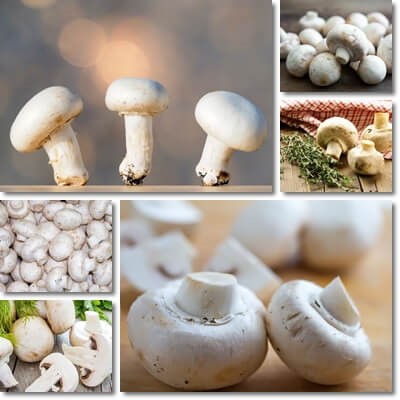The most common of mushrooms goes by the scientific name Agaricus bisporus and is none other than the portobello or portabella. In some circles it is better known as the champignon mushroom, cremini or crimini, table mushroom or even button mushroom, a name derived from its button-like appearance. Portobello mushrooms come in two colors, white and brown, and are sometimes called accordingly. They are eaten at various stages of maturity, both cooked and raw, and provide good nutrition. Portobello mushrooms are an important source of several essential vitamins and minerals, notably vitamins B2, B3, B5, phosphorus, potassium, selenium as well as protein and dietary fiber.
What do portobello mushrooms look like? Portobellos have a typical mushroom appearance: a stalk or stem called a stipe supporting a rounded, umbrella-shaped cap called a pileus. The stalk also has a thick, ring-like structure. The young, immature mushrooms look button-like, with a shorter, thicker stalk and a bulkier-looking cap, hence the alternative name ‘button mushrooms’. As the portobellos mature, the umbrella-like cap flattens. The cap can grow as big as 8-10 cm in diameter and develops elongated, gill-like structures underneath.

There are two varieties: white and brown portobellos. The gills are present in the more mature mushrooms, underneath the cap and are typically darker in color than the rest of the mushroom. Both the white and brown variety have pink, red-brown, then dark-brown to dark grey gills where the spores are contained. Both the stem and the cap feel smooth, but dry and the mushroom should be firm. Avoid mushrooms that are mushy or bruised and have spots that are not the same color as the rest of the cap or stem. Both the cap and stem have a smooth surface.
What do portobello mushrooms taste like? Portobello mushrooms have a mild taste with earthy, slightly nutty flavors. The brown variety is slightly more savory, or at least that’s how it seems to me. Flavor is also more pronounced in older mushrooms, those with a larger, flattened cap and gills visible underneath it. Baby portobello mushrooms are slightly less flavorful, but still a great choice, especially for anyone looking to start off with a more mildly-tasting mushroom. The cap and the gills underneath have a chewy, meaty texture, whereas the stem is more fibrous, but also slightly chewy. The entire portobello is edible, including the cap and gills underneath and the stem. It’s not only safe to eat, but also an important source of essential vitamins and minerals, protein and fiber overall.
Should you wash your portobello mushrooms? Yes, definitely. Whether they have been foraged from the wild (let’s say, a green, grassy pasture or field), or from the supermarket, portobello mushrooms have likely been in contact with manure. And manure harbors worms and intestinal parasites and their eggs, among others. It doesn’t hurt to at least rinse them well, even if the label says they’ve been washed already. They won’t lose their flavor or get soggy; they’ll just be clean and even safer to eat. But wash them only before using them; don’t let them sit in the fridge for days after washing them because that’s how they get soggy or moldy.

Nutrition facts
Portobello mushrooms stand out as having an excellent nutritional value, providing important amounts of several B group vitamins and dietary minerals and covering significant percentages of the recommended daily values of the essential nutrients. They are highest in vitamins B2, B3, B5, phosphorus, potassium and selenium and have good amounts of protein and dietary fiber as well.
Here are the most notable nutrition facts for 100 g of grilled portobello mushrooms:
Vitamin B2: 0.403 mg out of the recommended daily intake, RDI of 1.3 and 1.1 mg for adult men and women, respectively. Around 30% of average daily requirements of vitamin B2.
Vitamin B3: 6.255 mg out of the RDI of 16 and 14 mg for adult men and women, respectively. Roughly around 40% of average daily requirements of vitamin B3.
Vitamin B5: 1.262 mg out of the RDI of 5 mg. About 20% of average daily requirements of vitamin B5.
Phosphorus: 135 mg out of the RDI of 700 mg. Around 20% of average daily requirements of phosphorus.
Potassium: 437 mg out of the RDI of the 4700 mg. Slightly less than 10% of daily requirements.
Selenium: 21.9 mcg (micrograms) out of the RDI of 55 mcg. Around 43.5% of daily requirements.
Other nutrition facts of portobello mushrooms:
How many calories? Only 29 kcal (kilocalories) for 100 g of grilled portobellos.
How many carbs? Only 4.4 g of carbohydrates per 100 g of grilled mushrooms, of which 2.26 g are sugars in the form of glucose and 2.2 g dietary fiber.
How much protein and fat? There are 3.28 g of protein in a serving of 100 g of grilled mushrooms.
What are the benefits?
The benefits of portobello mushrooms are a result of their nutritional status, notably excellent content of several B group vitamins and dietary minerals, low carbohydrate content, low energetic value and good amounts of protein and dietary fiber.
1) Portobello mushrooms are low in calories (only 29 kcal/100 g), low in carbs (only 4.4 g of carbs) and fat (less than 0.6%) which makes them a good food for weight loss diets.
2) Can be included in a ketogenic diet as a result of their low carbohydrate content.
3) Good for nervous system, muscles and skin health thanks to high amounts of vitamins B2, B3 and B5.
4) Great anti-anemia food thanks to a generous vitamin B2 content (around 30% RDI in 100 g of grilled portobellos).
5) Eating portobello mushrooms helps combat fatigue, apathy, low mood, all thanks to a varied B vitamins profile, notably excellent amounts of vitamins B2, B3 and B5.
6) Potential benefits for high blood pressure thanks to good potassium content.
7) Encourages strong healthy bones and teeth thanks to good phosphorus content (and trace amounts of vitamin D, roughly 1% of daily requirements per 100 g).
8) Good food to eat for thyroid health as a result of an excellent selenium content.
9) Benefits for the immune system thanks to protein and zinc in particular.
10) Potential anti-inflammatory, antibacterial and antiviral properties and anticancer effects against certain types of liver and breast cancer.
11) With 2.2 g of dietary fiber per 100 g and over 90% water content, portobello mushrooms are a good food for maintaining normal transit time and bowel movements regularity, helping prevent constipation.
Sources:
1) Commonly consumed and specialty dietary mushrooms reduce cellular proliferation in MCF-7 human breast cancer cells. Martin KR, et al. Exp Biol Med (Maywood). 2010.
2) Cytotoxic effect of Agaricus bisporus and Lactarius rufus β-D-glucans on HepG2 cells.
Pires Ado R, et al. Int J Biol Macromol. 2013.
What are the side effects?
Like many other foods, portobellos can be a source of both benefits and side effects. Why are portobello mushrooms bad for you? In short, they have the potential to cause allergic reactions that could culminate with anaphylactic shock, they can transmit worms and intestinal parasites infections, may contain potentially carcinogenic compounds and even heavy metals.
1) Allergic reactions. While rare compared to other food allergies, portobello mushroom allergies are possible. If you know or suspect you are allergic, avoid them in all forms and preparations. Signs of an allergic reaction include itching and redness of the skin, itching of the mouth and throat, swelling of the face, mouth or throat, wheezing, difficulty breathing and, ultimately, anaphylactic shock.
2) Risk of parasitic infections. Portobello and other mushrooms are known to rise from piles of manure in the wild. In farming settings, they are cultivated in soil enriched with compost and even fresh manure. Whether they’re sourced from the wild or come from farms, portobellos hold a risk of parasitic infections which is why it’s advised to wash them well.
3) May contain carcinogens. This is probably the biggest health-related concern when it comes to the species. Portobello mushrooms have been found to contain agaritine, a probable human carcinogen and known animal carcinogen with yet unknown effects on humans, meaning the compound has potential cancer-causing effects. Inhalation from occupational exposure may pose a risk for lung cancer, while ingestion may pose a risk for bladder cancer. Another carcinogen in portobello mushrooms, gyromitrin, is suspected to cause liver cancer and is found in greater amounts in the Gyromitra esculenta mushroom species.
At the same time, portobellos also exhibit anticancer effects against various types of breast and liver cancer. According to studies available up to this point, eating portobello mushrooms in normal food amounts is not likely to be dangerous for human health. Carcinogenic effects are likely associated with excessive intakes over extended periods of time.
4) Potential source of heavy metals. Portobellos sourced from the wild have been found to contain heavy metals such as cadmium, copper, chromium, lead or nickle. All mushroom species are known to absorb heavy metals from the surrounding environment in a process called bioabsorption or bioaccumulation. It is not clear however how much of which heavy metals some mushrooms absorb from soil and other sources, but generally the more contaminated the soil, the higher and more varied the uptake of contaminants.
